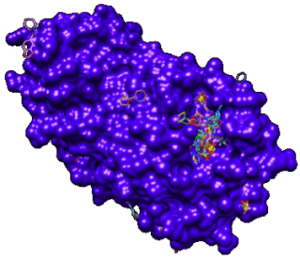Summary
The main protease (Mpro) in severe acute respiratory syndrome coronavirus 2 (SARS-CoV-2), the virus responsible for the coronavirus disease (COVID-19), has emerged as a promising drug target. The scientific community has produced a large number of crystallographic structures of the protease, which mediates viral replication and transcription. These structures report several fragments with varied chemotypes binding to different sites in Mpro. The main challenge at this stage is to effectively corroborate these valuable structural insights and expedite the search for any known drugs or natural products with properties similar to those fragments such that they can be rapidly translated for clinical testing against SARS-CoV-2. In this project, we build an artificial intelligence-based model using the available structural data of fragment-bound SARS-CoV-2 Mprocomplexes.Leveraging known drug-target interactions, our goal is to produce a machine learning algorithm capable of predicting potential drugs that can be repurposed for the treatment of COVID-19. We explore the potentials of small molecules, including drugs, natural products, and quantum dots to identify promising structures for inhibiting and/or detecting the SARS-CoV2 virus. Our results are expected to provide useful insights into the readily available therapeutic resources and help in the fight against the COVID-19 pandemic.
Related Content

Qubits and Quantum Effects in Biology
It is unknown whether biological processes make direct use of quantum effects, as opposed to depending merely on the influence of quantum physics on chemical bonding and molecular structure.
June 1, 2017

Cryo-CMOS to Control and Operate 2D Fault-Tolerant Qubit Network
Summary Large-scale, fault-tolerant quantum computation requires precise and stable control of individual qubits. This project will use complementary metal-oxide-semiconductor (CMOS) technology to provide a cost-effective scalable platform for reliable and high-density control infrastructure for silicon spin qubits. We will use sub-micron CMOS technology to address device and circuit-level challenges and explore the integration of […]
June 14, 2018

Quantum Material Multilayer Photonic Devices and Network
Summary Realizing highly integrated quantum photonic devices on a chip can enable new opportunities for photonic quantum computation. In this project, we explore heterostructures of stacked two-dimensional (2D) materials, such transition metal dichalcogenides (TMDC) or graphene, combined with optical microcavities as a platform for such devices. 2D materials are extremely thin and flexible, and have […]
December 12, 2019

Developing Tools for Quantum Characterization and Validation
Summary Coherence is essential for quantum computation; yet it introduces a unique sensitivity to any imperfections in hardware design, control systems, and the operating environment. Overcoming these sensitivities requires a hierarchy of strategies, ranging from optimization of the hardware architecture to software solutions including quantum error correction. Randomized Benchmarking Protocols are an important family of […]
October 3, 2017


